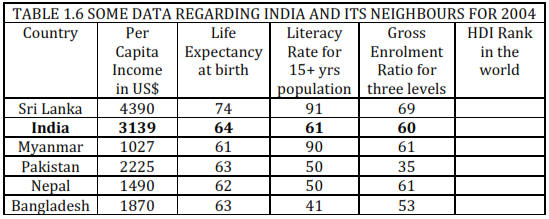NCERT Solution: Development
The issue of sustainability is important for development because development must be in tandem with the future. If natural resources are not sustained, then development will stagnate after a point of time. Exploiting resources unethically will ultimately undo the development that a country may have achieved. This is because in the future, those resources will not be available for further progress.
"The Earth has enough resources to meet the needs of all but not enough to satisfy the greed of even one person". This statement is relevant to the discussion of development since both resources and development go hand in hand. For the sustainability of development, the maintenance of resources is also crucial. As the statement claims, the Earth has enough resources- renewable and non-renewable to satisfy everyone's needs; however, these need to be used with a view to keep the environment protected and clean so that a balance of production and use is maintained, and shortages are avoided.
Few examples of environmental degradation:
→ Deforestation
→ Soil erosion
→ Falling levels of ground water
→ Depletion of the ozone layer and combustion from automobiles causing extreme air pollution
→ Water Pollution

Answer
(i) Per Capita Income in US$: Top country - Sri Lanka; Bottom country - Myanmar
(ii) Life Expectancy at birth: Top country - Sri Lanka; Bottom country - Myanmar
(iii) Literacy Rate for 15+ yrs population: Top country - Sri Lanka; Bottom
country - Bangladesh
(iv) Gross Enrolment Ratio for three levels: Top country - Sri Lanka; Bottom
country - Pakistan
(v) HDI Rank in the world: Top country - Sri Lanka; Bottom country - Nepal

(i) Compare the nutritional level of people in Kerala and Madhya Pradesh.
(ii) Can you guess why around 40 per cent of people in the country are
undernourished even though it is argued that there is enough food in the
country? Describe in your own words.
Answer
(i) The nutritional level of people of Kerala is quite higher than the people �
both males and females of Madhya Pradesh. Their ratio of the under-nourished is
less than that of Madhya Pradesh.
(ii) There is enough food in the country, even then 40% of the people in the
country are undernourished because:
→ A large number of people are so poor that they cannot afford nutritious food.
→ In most of the states, the Public Distribution System (PDS) does not function
properly and the poor people cannot get cheap food items.
→ There is lack of educational and health facilities in many parts of the
country. So many people remain backward and poor. As such, they are unable to
get nutritious food.
Q.1 The total income of the country divided by its total population is Called:
(a) National income (b) Per capital income
(c) Total income (d) None of these
Q.2 Which organization publishes the Human Development Report:
(a) WHO (b) UNDP
(c) WTO (d) IMF
Q.3 Development of a country generally be determined by:
(a) its per capita income (b) its literacy level
(b) health status of its people (d) all above
Q.4 As per Human Development Report 2006 which neighboring country has the highest income following –
(a) Sri Lanka (b) India
(c) Pakistan (d) Nepal
Answer key of MCQ: 1. (b) 2. (b) 3. (d) 4. (a)
Different people have different goals for development because:
Different people have different aspiration and desire. Some may like to have `more income and better quality of
education for their children, while others may require no social discrimination and high support price for their
crops. So according to the living conditions and the environment in which the person stays, he or she pursue for the
goals. People seek things that are most important for them i.e., that which can fulfill their aspiration or desires.
The total income of the country is the income of all the residents of the country. For comparison between
countries, total income is not such a useful measure. Since countries have different population, comparing total
income will not tell us what an average people is likely to earn. Hence we compare the average income which is
the total income of the country divided by its total population.
So, Average income = Total income / Total population
The average income is also called per capita income.